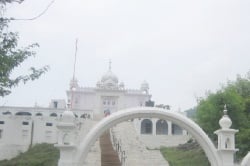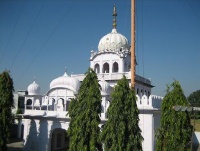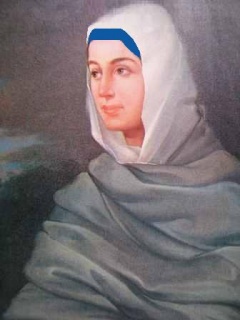Mata Jito
| Mata Ajeet Kaur | |
| Full Name : | Ajeet Kaur, Jeeto, Jito |
| Birth : | 1673, Lahore |
| Parents : | Bhai Harjas |
| Spouse : | Guru Gobind Singh |
| Children : | Ajit Singh, Jujhar Singh, Zorawar Singh, Fateh Singh |
| Death : | 5 Dec, 1700, Anandpur Sahib |
Version I
This argument bases its claim on several historical 'granths'.
Mata Jito, who was also called Mata Jeet kaur was the first wife of Guru Gobind Singh Ji. She was the daughter of Bhai Harijas, a Subhikkhi Khatri of Lahore. The betrothal had taken place in 1673. The father-in-law had desired that the bridegroom should come at the head of a marriage party to Lahore where the ceremony should be performed with due dignity.
The fateful events leading to the martyrdom of Guru Tegh Bahadur intervened, and in the changed circumstances it was not possible for the young Guru to go to Lahore. Therefore a temporary encampment was raised near the village of Basantgarh, 10 km north of Anandpur, and named Guru ka Lahore where the nuptials were held on 23 Har 1734 Bk/21 June 1677.
On 30th March 1699, Guru Gobind Singh created the Khalsa at Anandpur. He declared that this Khalsa will be both Saints as well as Soldiers. When Gobind Singh was preparing amrit (nectar) for initiating the Khalsa, on this occasion , stirring clean water in an iron bowl with a Khanda or double-edged sword, Mata Jitoji, as the tradition goes, came with sugar crystals which were dropped into the vessel at the Guru's bidding. Sweetness was thus added to the alchemy of steel. Mata Jito ji was the first Khalsa Woman.
Three sons were born to Mata Jito ji — Jujhar Singh (14March 1691), Zorawar Singh (17 November 1696) and Fateh Singh (25 February 1699). Mata Jito Ji raised her three sons on the martyrdom tales of their grandfather Guru Tegh Bahadur and great great grandfather Guru Arjan Dev ji. She told them a Sikh never runs from a battle field. It was because of her teachings that all her three sons attained Martyrdom Jujhar Singh when was only 15 years old fighting with Mughals at Chamkaur, Zorawar Singh and Fateh Singh who were only 9 and 6 years old at the hands of Wazir Khan, Mughal Governor of Sirhind, when the young Sahibzades would not convert to Islam.
Mata Jitoji left this world at Anandpur on 5 December 1700, years before the martyrdom of her sons or the events leading to the battle of Chamkaur. The cremation took place at Agampura, near the Holgarh Fort. A memorial shrine now stands upon the spot.
Claims by Modern Sikhs
Modern Scholars claim that Guru Gobind Singh had only one marriage and that Mata Jito and Mata sundari were indeed the same person. They explain that Mata Gujri was also known by the name Sundari as she was very beautiful and this was tradition of punjab?
The sources which infer that Mata Jito and Mata Sundri were separate personalities are the Gur Partap Suraj Granth by Bhai Santokh Singh, the Twarikh Guru khalsa, by Giani Gian Singh, the Bansavalinama Dasan patshahiyan Ka, by Kesar Singh Chibber, the Mahankosh, by Kahn Singh Nabha and the Encyclopedia of Sikhism, by Harbas Singh of Patiala University. In addition to this there is a memorial related to the marriage at Guru ka Lahore and another memorial Related to Death at Anandpur.
This begs the question, if there was only one wife then why did so many great Punjab historians not write these facts, or should we say, why were they so unaware of punjabi culture? Is it possible that they wrote huge granths and don't know about punjabi culture?
There's gurdwara sahib called Gurdwara mata Jito Ji at anandpur where last rites of mata ji were performed and Mata sahib Kaur ji last rites were performed at Gurdwara bala Sahib Delhi. Mata Sundri's last rights were also performed in Delhi.
References
- Gur Partap Suraj granth by bhai Santokh Singh
- Twarikh Guru khalsa Giani Gian Singh
- Bansavalinama Dasan patshahiyan Ka by Kesar Singh Chibber
- Mahankosh By Kahn Singh nabha
- Encyclopedia of Sikhism by Harbas Singh of Patiala University
- Memorial related to marriage at Guru ka Lahore
- Memorial Related to Death at Anandpur
- Gurdwara where Ajeet Kaur was cremated
Apparently there are differing opinions as to whether Guru Gobind Singh had only one wife, like the other Gurus or in the Mughal or Islamic fashion had several wives. (The arguments stated in this page for the multiple wives theory does not make it clear whether the two (or is it three?) wives were successive or at the same time.
Version II
This argument bases its claim on the work of recent research.
Mata Ajeet kaur (Mata Jeeto) or Mata Sunder Kaur(Mata Sundri) was the wife of Guru Gobind Singh ji (1666-1708), the daughter of Bhai Ram Saran, a Kumarav Khatri of Bajwara, in present-day Hoshiarpur district of the Punjab. She was married to Guru Gobind Singh at Anandpur on 4 April 1684. The father-in-law had desired that the bridegroom should come at the head of a marriage party to Lahore where the ceremony should be performed with due dignity. The fateful events leading to the martyrdom of Guru Tegh Bahadur ji intervened, and in the changed circumstances it was not possible for the young Guru to go to Lahore. Therefore a temporary encampment was raised near the village of Basantgarh, 10 km north of Anandpur, and named Guru ka Lahore where the nuptials were held on 23 Har 1734 Bk/21 June 1684. Mata Jito ji became Mata Sundari ji after marriage as was the custom in Punjabi families. Four sons were born to Mata Jito ji/Sundari ji - Baba Ajit Singh ji, Baba Jujhar Singh ji (14 March 1691), Baba Zorawar Singh ji (17 November 1696) and Baba Fateh Singh ji (25 February 1699). Mata ji received Amrit at the 1699 Vaisaakhi Amrit Sanchaar and adopted the name 'Sunder Kaur'. Mata Sundari ji raised her four sons on the martyrdom tales of their grandfather Guru Tegh Bahadur ji and great great grandfather Guru Arjan Dev ji. She told them a Sikh never runs from a battle field. It was because of her teachings that all her four sons attained Martyrdom. Baba Ajit Singh the oldest, Baba Jujhar Singh ji when was only 15 years old fighting with Mughals at Chamkaur, Baba Zorawar Singh ji and Baba Fateh Singh ji who were only 9 and 6 years old at the hands of Wazir Khan, Mughal Governor of Sarhind, when the young Sahibzades would not convert to Islam. During the evacuation of Anandpur on the night of 5-6 December 1705, Mata Sundari ji, along with Mata Sahib Devan (who adopted the name 'Sahib Kaur' after recieving Amrit), was escorted by Bhai Mani Singh ji to Delhi.
Gurdwara Mata Sunder Kaur in Poor Condition
She rejoined Guru Gobind Singh in 1706 at Talwandi Sabo, where she heard the news of the martyrdom of her sons also of the death of her aged mother-in-law, Mata Gujar Kaur ji. She went back to stay at Delhi while Guru Gobind Singh left Talvandi Sabo for the South. At Delhi, Mata Sundari ji adopted a young boy whom she named Ajit Singh because of his resemblance to her own late son, Sahibzada Ajit Singh ji. After the passing away of Guru Gobind Singh ji at Nanded in October 1708, the Sikhs looked up to her for guidance. She appointed Bhai Mani Singh ji to manage the sacred shrines at Amritsar and also commissioned him to collect the writings of Guru Gobind Singh ji. She also issued under her own seal and authority hukamnamas to sangats. The hukamnamas since discovered and published bear dates between 12 October 1717 and 10 August 1730.
Mata Sundari ji was disappointed in her adopted son, Ajit Singh. Emperor Bahadur Shah treated him as the successor of Guru Gobind Singh ji, called him to his court and gave him a robe of honour in September 1710. This went to his head and he started living in style as a courtier. He grew arrogant and haughty even towards Mata Sundari who disowned him, and migrated to Mathura.
Ajit Singh was later convicted for murder and was put to death on 18 January 1725. Mata Sundari ji returned to live in Delhi where she, died in 1747. A memorial in her honour stands in the compound of Gurdwara Bala Sahib, New Delhi.
Article taken from this book. Encyclopedia of Sikhism edited by Harbans Singh ji.
NOTE: (based on the following results on the research by Dr. Gurbaksh Singh ji)
The wrong impression that the Guru had more than one wife was created by those writers who were ignorant of Punjabi culture. Later authors accepted those writings indicating more than one marriage of the Guru and presented it as a royal act. During those days kings, chiefs, and other important people usually had more than one wife as a symbol of their being great and superior to the common man. Guru Gobind Singh ji, being a true king, was justified in their eyes to have had more than one wife, but this is actually incorrect.
In Punjab, there are two and sometimes three big functions connected with marriage, i.e., engagement, wedding, and Muklaawaa. Big gatherings and singings are held at all these three functions. In many cases, the engagement was held as soon as the person had passed the infant stage. Even today engagements at 8 to 12 years of age are not uncommon in some interior parts of India. The wedding is performed a couple of years after the engagement. After the wedding, it takes another couple of years for the bride to move in with her in laws and live there. This is called Muklaawaa. A dowry and other gifts to the bride are usually given at this time of this ceremony to help her to establish a new home. Now, the wedding and Muklaawaa are performed on the same day and only after the partners have become adults.
A big function, befitting the Guru and other joyful activities were held at Anand Pur, according to custom, at the time of the engagement of the Guru. The bride, Mata Jeeto Ji, resided at Lahore, which was the capital of the Mughal rulers who were not, at that time, on good terms with the Guru. When the time for the marriage ceremony came, it was not considered advisable for the Guru to go to Lahore, along with the armed Sikhs in large numbers. Furthermore, it would involve a lot of traveling and huge expenses, in addition to the inconvenience it would cause the Sangat, especialy the younger and older members, who wished to witness the marriage of the Guru.
Therefore, as mentioned in the Sikh chronicles, Lahore was 'brought' to Anand Pur Sahib for the marriage instead of the Guru going to Lahore. A scenic place a couple of miles to the north of Anand Pur was developed into a nice camp for the marriage. This place was named Guru Ka Lahore. Today, people are going to Anand Pur to visit this place as well. The bride was brought to this place by her parents and the marriage was celebrated with a very huge gathering attending the ceremony.
The two elaborate functions, one at the time of engagement and the other at the time of the marriage of the Guru, gave the outside observers the impression of two marriages. They had reason to assume this because a second name was also there, i.e., Mata Sundari Ji. After the marriage, there is a custom in the Panjab of giving a new affectionate name to the bride by her inlaws. Mata Jeeto Ji, because of her fine features and good looks, was named Sundari (beautiful) by the Guru's mother. The two names and two functions gave a basis for outsiders to believe that the Guru had two wives. In fact, the Guru had one wife with two names as explained above.
Some historians even say that Guru Gobind Singh ji had a third wife, Mata Sahib Kaur. In 1699, the Guru asked her to put pataasas (puffed sugar) in the water for preparing Amrit when he founded the Khalsa Panth. Whereas Guru Gobind Singh ji is recognized as the spiritual father of the Khalsa, Mata Sahib Kaur ji is recognized as the spiritual mother of the Khalsa. People not conversant with the Amrit ceremony mistakenly assume that Mata Sahib Kaur ji was the wife of Guru Gobind Singh ji. As Guru Gobind Singh ji is the spiritual but not the biological father of the Khalsa, Mata Sahib Devan ji is the spiritual mother of the Khalsa, Mata Sahib Devan is the spiritual mother of the Khalsa but not the wife of Guru Gobind Singh. From ignorance of Punjabi culture and the Amrit ceremony, some writers mistook these three names of the women in the life of Guru Gobind Singh as the names of his three wives.
Another reason for this misunderstanding is that the parents of Mata Sahib Devan, as some Sikh chronicles have mentioned, had decided to marry her to Guru Gobind Singh ji. When the proposal was brought for discussion to Anandpur, the Guru had already been married. Therefore, the Guru said that he could not have another wife since he was already married. The dilemma before the parents of the girl was that, the proposal having become public, no Sikh would be willing to marry her. The Guru agreed for her to stay at Anand Pur but without accepting her as his wife. The question arose, as most women desire to have children, how could she have one without being married. The Guru told, "She will be the "mother" of a great son who will live forever and be known all over the world." The people understood the hidden meaning of his statement only after the Guru associated Mata Sahib Devan with preparing Amrit by bringing patasas. It is, therefore, out of ignorance that some writers consider Mata Sahib Devan as the worldly wife of Guru Gobind Singh.



